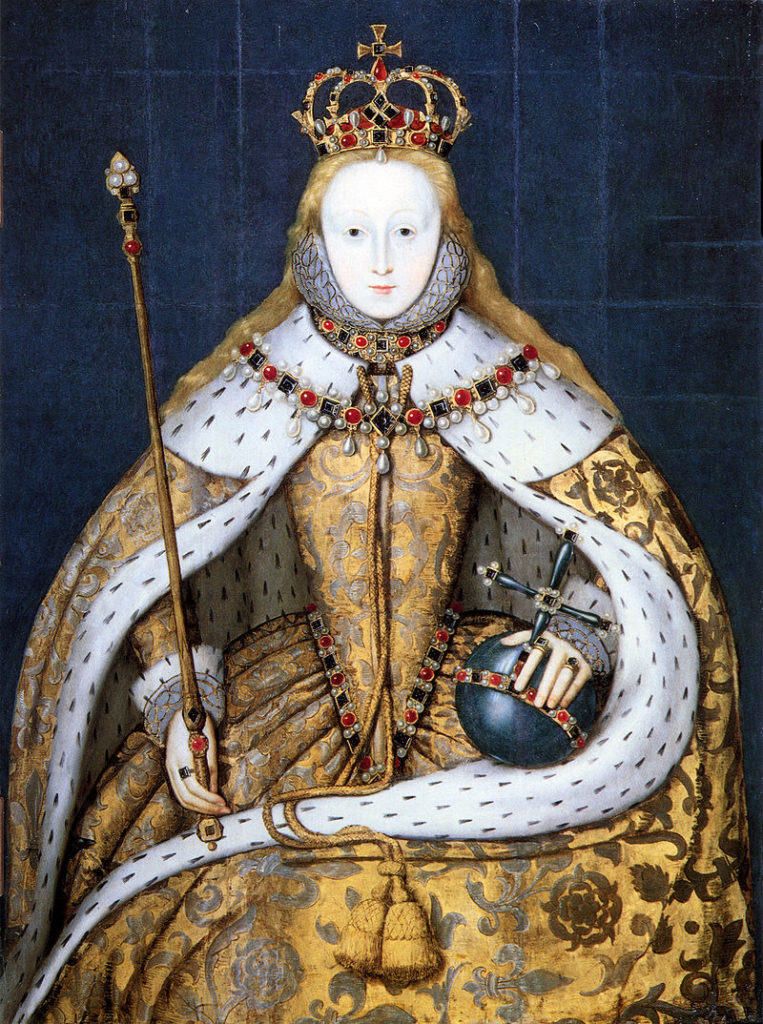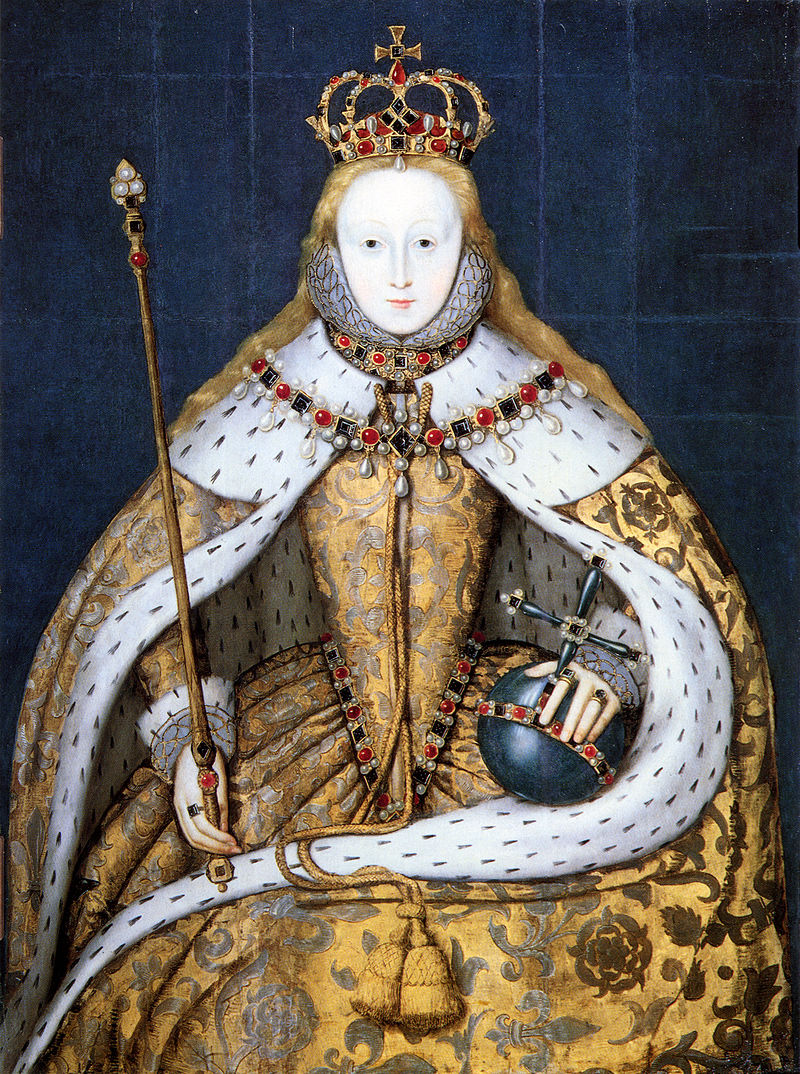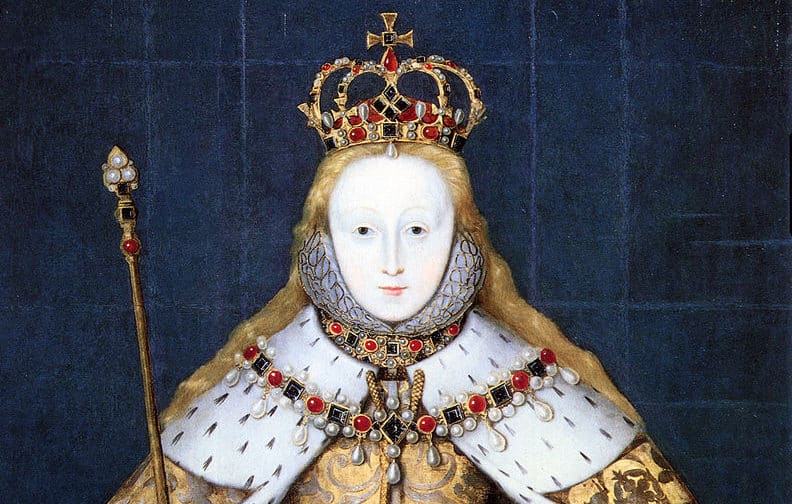
A coronation was actually a two-day affair: the first day involved the monarch’s procession through the capital city, the second was the religious ceremony in which s/he was anointed and crowned.
Her procession through London on January 14th featured five stations displaying pageants that emphasized poems and orations (rather than a heavier reliance on the tableaux vivants more popular during the Middle Ages) where she was depicted as a savior of the Protestant faith, a new Deborah. At Mary’s death, the English treasury was “utterly exhausted” and so there is every reason to expect that that the pomp might have been slightly abbreviated. But Elizabeth had always shown herself to be brilliant at the things that mattered: the opportunity for natural propaganda and for cementing a sovereign’s hold on subjects’ hearts. So she economized on that first day by re-using her sister’s old coronation gowns and some of the giant figures created for Mary’s wedding to Philip – and focused on creating personal moments with as many people as possible. In Agnes Strickland’s words:
“The City of London might, at that time, have been termed a stage, wherein was shown the spectacle of the noble-hearted queen’s demeanor towards her most loving people, and the people’s exceeding joy at beholding such a sovereign, and hearing so princely a voice. How many nosegays did her grace receive at poor women’s hands! How often stayed she her chariot, when she saw any simple body approach to speak to her!”
The ceremony itself presented far more pitfalls to Elizabeth – including one issue that consumed several weeks of consideration. For political expedience, Elizabeth had decided she wanted to be crowned according to the rites of the Church of Rome…but still take on the title of Supreme Head of the Church of England. So who would crown her? That should have been the duty of the Archbishop of Canterbury – and the last holder of that post, Thomas Cranmer, would have been delighted to do so had he not been burned for heresy. Next in line was the Archbishop of York, but he was a devout Catholic who refused to name Elizabeth as Supreme Head of the Church – a resistance that was matched by bishop after bishop who had been appointed by Mary… At the last minute, the Bishop of Carlisle (Dr. Oglethorpe) borrowed vestments from the Bishop of London (Edmund Bonner) and fulfilled the role.
With that solution out of the way, the ceremony could proceed. The following is taken from Strickland, quoting liberally from John Nichols’ The Progresses and Public Processions of Queen Elizabeth (I have eliminated the double quotes, footnotes, and also some text relating to a side issue):
The path for the queen’s procession was railed in, and spread with blue cloth. The queen was conducted, with the usual ceremonies, to a chair of state at the high altar: she was then led by two noblemen to the platform for recognition, and presented by bishop Oglethorpe as queen, trumpets blowing between every proclamation. When she presented herself at the high altar, she knelt before Oglethorpe and kissed the cover (veil) of the paten and chalice, and made an offering in money. She returned to her chair while bishop Oglethorpe preached the sermon and “bade the beads;” then the queen, kneeling, said the Lord’s Prayer. On being reseated, the bishop administered the coronation oath: the precise words of it are omitted, but it has been asserted that it was the same exacted from James I and the Stuart kings of England who were required to take a similar oath – viz.,, to keep the church in the same state as did king Edward the Confessor.
When bishop Oglethorpe was kneeling before the altar, the queen gave a little book to a lord to deliver to him, which he at first refused to receive and read in other books; but immediately afterwards tool the queen’s book and read it before her grace. It is supposed that the queen sent, with her little book, a request that Oglethorpe would read the gospel and epistle in English which was done. Then the bishop sang…the mass from a missal, which had been carried in procession before the queen. A carpet was spread before the high altar, and cushions of gold cloth placed upon it; and then secretary Cecil delivered a book to the bishop, another bishop standing at the left of the altar. The queen now approached the altar, and leaned upon cushions, while her attendants spread a silken cloth over her and the bishop anointed her. It seems she was displeased at this part of the ceremony, for when it was finished, and she retired behind her traverse to change her dress, she observed to her maids that the oil was grease, and smelled ill.
When she reappeared before the public in the abbey, she wore a train and mantel of cloth of gold furred with ermine. Then a sword with a girdle was put upon her, the belt going over one shoulder and under the others; two garters were put on her arms; these were the armillae or armlets, and were not connected with the order of the Garter. Then the bishop put the crown upon her head, and delivered the scepter into her hand. She was then crowned with another crown – probably the crown of Ireland – the trumpets again sounding. The queen then offered the sword, laying it on the altar, and knelt, with the scepter and cross in her hand, while the bishop read from a book. The queen then returned to her chair of state, the bishop put his hands into her hands, and repeated certain words. And then the lords went up to her grace, kneeling upon their knees and kissing her grace.[…]
Then the bishops began the mass, the epistle being read, first in Latin, and then in English; the gospel the same – the book being sent to the queen, who kissed the gospel. She then went to the altar to make her second offering, three unsheathed swords being borne before her, and one in the scabbard. The queen, kneeling, put money in the basin and kissed the chalice; and then and there certain words were read to her grace. She retire to her seat again during the consecration and kissed the pax. She likewise received the eucharist but did not receive from the cup. When mass was done, she retired behind the high altar and as usual, offered her crown, robes and regalia in St. Edward’s chapel; coming forth again with the state crown on her head and robed in violet velvet and ermine, and so proceeded to the banquet in Westminster hall.
The champion of England, sir Edward Dymock, performed his official duty by riding into the hall, in fair, complete armor, upon a beautiful courser richly trapped with gold cloth. He cast down his gauntlet in the midst of the hall as the queen sat at dinner, with offer to fight him, in the queen’s rightful quarrel, who should deny her to be the lawful queen of this realm. The proclamation of the heralds on this occasion an historical and literary curiosity. The right the champion offered to defend was according to the proclamation of Mr. Garter king-at-arms, that ‘of the most high and mighty princess, or dread sovereign lady Elizabeth by the grace of God queen of England, France, Ireland, defender of the true, ancient,, and Catholic faith, most worthy empress from the Orcade isles to the mountains Pyrenee. A largesse, a largess, a largess.’
RESOURCES
Agnes Strickland, Lives of the Queens of England, Volume VII
John Nichols, The Progresses and Public Processions of Queen Elizabeth
***
If you like my posts, you’ll love my books! My Seymour Saga trilogy tells the gripping story of the short-lived dynasty that shaped the Tudor Era. Jane the Quene skews romantic, The Path to Somerset is pure Game of Thrones (without the dragons), and The Boy King is a noir coming-of-age. Get them now through Amazon, Barnes & Noble, Kobo, and Apple, or even your local independent bookstore!

(PS Already read them? Did you love them? Then please review them – even just a stars rating! It makes a huge difference in helping new readers find them and would mean the world to me!)


Be First to Comment